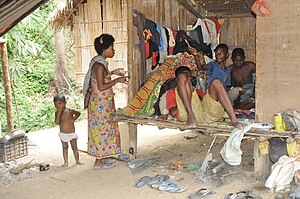
Back Pueblo batek Spanish Batek (peuple) French Bateq ID Bateq Malay பாத்தேக் மக்கள் Tamil 巴特克人 (馬來西亞) Chinese
 A Batek family | |
| Total population | |
|---|---|
| 1,359 (2010)[1] | |
| Regions with significant populations | |
| Languages | |
| Batek language, Malay language | |
| Religion | |
| Traditional religion and significant adherents of Islam, Christianity and Buddhism. | |
| Related ethnic groups | |
| Semang (Jahai people, Lanoh people), Negritos (Maniq people, Philippine Negritos, Andamanese) |
The Batek (or Bateq) people are an indigenous Orang Asli people (numbering about 1,519 in 2000[2]); belonging to the Semang group, who live in the rainforest of peninsular Malaysia. As a result of encroachment, they now primarily inhabit the Taman Negara National Park. The Batek are nomadic hunters and gatherers, so the exact location of their settlements change within the general confines of the area that they inhabit.[3]
The common phrase used to refer to them, 'orang asli', signifies a diverse group of which the Batek tribe is a part. It means 'original people' in Malay and was probably first used to identify these people by the British. The Batek, however, refer to themselves as 'Batek Teh', which means "forest people".[4] The Malay Srivijaya empire came in contact with the Negrito. Historically they traded with the local populations while other times they were subjected to exploitation, raids, slavery in Malaya, paying tributes to the Malays. For more than a thousand years, some Negrito tribes from the southern forests were enslaved and exploited until modern times while others remain in isolation and avoided contact.[5]
The Batek people were first documented by Europeans in 1878, when explorer-naturalist Nicholai Miklukho-Maklai of Russia wrote about them.[6]
Until about 1970 much of inland peninsular Malaysia was difficult to reach for the purposes of logging, so the Batek were widespread throughout that region. Since it is now possible to harvest the trees in that region, the Batek are largely confined to Taman Negara National Park and the surrounding region.[7]
- ^ Kirk Endicott (2015). Malaysia's Original People: Past, Present and Future of the Orang Asli. NUS Press. p. 2. ISBN 978-99-716-9861-4.
- ^ "Orang Asli Population Statistics". Center for Orang Asli Concerns. Archived from the original on 2012-02-09. Retrieved 2008-02-12.
- ^ Bonta, Bruce D. Peaceful Peoples: an Annotated Bibliography ISBN 0-8108-2785-9. Metuchen NJ: Scarecrow, 1993 Page 29-31
- ^ Cite error: The named reference
:0was invoked but never defined (see the help page). - ^ Archives of the Chinese Art Society of America
- ^ Endicott, Kirk. “The Batek of peninsular Malaysia.” The Cambridge Encyclopedia of Hunters and Gatherers ISBN 0-521-57109-X. 2004 Page 298
- ^ Lye, Tuck-Po. Changing Pathways: Forest Degradation and the Batek of Pahang Malaysia ISBN 0-7391-0650-3. Lanham, MD: Lexington, 2004 Page 2-4